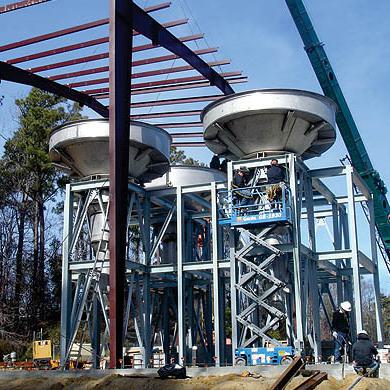Getting an Energy Boost from Co-Digestion though ESCO Project Delivery
Last Modified Mar 24, 2022
Introduction:
Broward County owns and operates the 95-mgd North Regional Wastewater Treatment Plant (NRWWTP), located in Pompano Beach, Florida. Liquids processing systems include preliminary treatment, secondary treatment through an activated sludge process and standard disinfection. Waste activated sludge is thickened by dissolved air flotation prior to conventional anaerobic digestion. Class B biosolids are dewatered by belt filter presses and dewatered cake is hauled to either land application sites or to landfills.
The NRWWTP utilizes 5 megawatts of electricity, making it one of the largest single point electrical consumers in Broward County. Broward County has adopted a Climate Change plan with goals to reduce carbon emissions to 1997 levels by 2015. Currently, 25% of digester gas is used for digester heating and the remaining 75% of digester gas production is flared to atmosphere.
Project Objectives and Benefits:
Broward County Water and Wastewater Services hired Chevron Energy Solutions Company (now Opterra Energy Solutions) and its partners, including Hazen and Sawyer, under an energy savings performance contract. The Opterra team identified and developed a “Waste to Green Energy Project” consistent with the County’s Climate Change plan. The primary objectives of the project are to reduce the plant’s energy consumption and carbon emissions by beneficially using flared biogas, a renewable energy source, for Combined Heat and Power (CHP) to generate electricity onsite. A major component of the project was to co-digest another wasted resource, FOG (fats, oils and greases), to increase biogas production, thereby increasing electricity generation and further reducing energy consumption and carbon emissions. Successful implementation of the project results in the following environmental and financial benefits:
- Redirection of FOG out of the liquid treatment process reduces aeration energy
- Overall reduction in energy costs by $1.5 million per year
- Reduction of annual CO2 emissions by 21,000 CO2 tons equivalents (equivalent to taking 4,000 cars off the road)
- Reduction of the treatment plant’s carbon footprint by over 50%
Related Topics:

FOG Receiving, Storage, Blending, and Dosing Facilities:
FOG was previously received at the NRWWTP’s Septage Receiving Facility and co-mingled with septage before discharging to the plant influent. Receiving FOG through the liquids process has had several adverse O&M impacts, including pipeline blockages and increased aeration energy demands. FOG characteristics have been highly variable, with total solids ranging from 1% to 20% and chemical oxygen demand (COD) ranging from 10,000 mg/L to 150,000 mg/L. FOG quantities also exhibit significant variability, with average daily volumes of 60,000 gallons per day and maximum day sustained volumes of 136,000 gallons per day.
The new FOG Receiving Facility includes two truck unloading stations; a 165,000 gallon stainless steel FOG receiving tank; FOG transfer pumping to an 18,500 gallon blend tank; and dosing pumps. Digested sludge is recirculated from the digesters to the blend tank where it is mixed at a 10:1 ratio (sludge/FOG). The sludge/FOG blend is dosed into each digester’s feed line on a timed cycle to prevent shock loading to the digesters. The receiving tank equalizes FOG volumes and dampens the load-to-load variation in FOG strength, thereby providing a consistent FOG loading rate to the digestion process. FOG tanks are vented to an existing odor control system. FOG in the receiving tank is recirculated and heated. FOG piping is fitted with hot water flushing connections. Coupled with blending FOG with sludge in the dosing system, these design features prevent FOG from congealing and creating line blockages.

Since maximum sustained FOG dosing can exceed historically “safe” limits for co-digestion, initial FOG dosing will be controlled in multiple steps, with each step increasing volatile solids loading by no more than 5%.
FOG Loading to Digesters:
Microorganisms within the anaerobic digesters need time to acclimate to increased organic loading from high strength wastes such as FOG or food wastes. Overdosing lipid-rich material can lead to accumulation of long chain fatty acids (LCFAs), which in turn can cause a drop in pH, stress microbes and inhibit methane formation. Based on relatively limited industry experience, the “safe” limit for FOG dosing is generally considered to be 30% by weight of total volatile solids in the digester feed. Recent research has demonstrated that if FOG dosing is increased slowly and gradually, digester microorganisms can adapt and support higher FOG loading. In addition, gradual step increases in FOG dosing have increased the ultimate “ceiling” for FOG dosing and maximized ultimate biogas production for beneficial use.
Projected FOG quantities will result in average FOG dosing of 25% to 30% and maximum sustained dosing of 40% by weight of volatile solids feed to the digesters. Since maximum sustained FOG dosing can exceed historically “safe” limits for co-digestion, initial FOG dosing will be controlled in multiple steps, with each step increasing volatile solids loading by no more than 5%. It is anticipated that 5 to 10 total steps will be required, and that each step will last at least 7 days to allow adequate digestion process monitoring.
This presentation will address the following in detail:
- Design criteria and concepts for FOG receiving and dosing to digesters
- FOG dosing startup and digestion process monitoring plan
- Digester performance during step-increase of FOG dosing
- Data on enhanced digester gas production
- Data on benefits, including FOG contribution to electricity generation and carbon reduction











